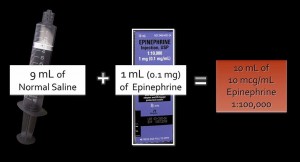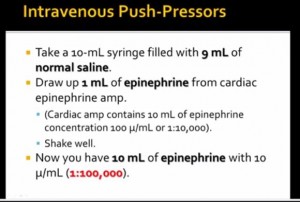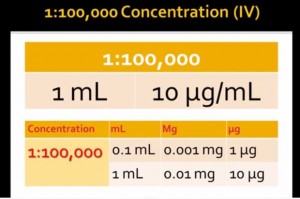Dr. Larry Mellick’s YouTube channel is simply one of the very best medical education resources available anywhere on the internet.
His recent YouTube video “Pulse Dose Epi During Intubation” is outstanding. And after you have watched it, go to YouTube and review all the excellent comments about the video and Dr. Mellick’s responses (and, of course, you can also watch the video there). [4-6-2014: See Addendum at the end this post where Dr. Mellick answers a question about puse dosing of epinphrine in pediatric patients]
________________________________________________________________Notes from Pulse Dose Epi During Intubation
From an earlier video, Pulse Dosing For Hypotension, Dr. Mellick states that the usual dose of 1:100,000 epinephrine [what we just made] is 0.5 ml to 2 ml IV push followed by a normal saline flush every two to five minutes.
For more information on the use of pulse dosing of epinephrine in the treatment of hypotension, please see my blog post of Sept 13, 2013: Pulse Dosing of Epinephrine or Phenylephrine for Hypotension. This post features a different YouTube video from Dr. Mellick on the same topic. In addition, there is a link to to an excellent podcast about pulse dosing of pressors in hypotension from Dr. Scott Weingart from www.emcrit.org titled EM Podcast 6—Push Dose Pressors. Don’t miss all the bonus content on the page. On the page there are printed directions on how to mix epinephrine and phenylephrine for pulse dosing and there also videos showing how to do each mix.
Notes from the above Video:
When Should I Use Pulse Dosing?
- Unstable patient at risk during or following intubation.
- As a bridge in hypotensive patients before beginning the vasopressor infusion.
- For hypotensive anaphylaxis patients who need immediate epinephrine in their veins.
Case shown in the video:
A patient with end-stage renal disease s/p 2010 kidney transplant. CAD with 15-20% ejection fraction. Sepsis and hypotension. Cholecystitis and ascending cholangitis.
Patient requires intubation and so receives RSI. His pressure falls to 79/44 (54). The patient received 10 mcg of epinephrine IV and blood pressure improved. 10 mcg of epi is one ml of the 1:100,000 epi that was prepared at the start of the video.
Addendum added 4-6-2014:
In the comments section that follows his video on Youtube, a viewer asks: What is the pulse dose of epinephrine that one would use in pediatric patients?
Dr. Mellick replies:
“Very little recommendations out there for pediatric patients. No clear guidelines. However, here what I wrote on a blog for EM News as a suggested recommendation. You can find the whole article on line.
https://journals.lww.com/em-news/blog/M2E/pages/post.aspx?PostID=19 “The pulse dose epinephrine concentration can be used for children as well as adolescents and adults. Anaphylaxis with hypotension in children can also be treated with a continuous epinephrine infusion and the standard dosing is 0.1-1 mcg/kg/min titrated to effect. Pulse dosing, however, is potentially more timely and appropriate for the hypotensive child. The preparation of the pulse dose epinephrine concentration is the same for adults and children. The smaller pulse doses for a child would be 0.1 ml/kg/dose of the 1,100,000 pulse dose concentration. This amount is 0.001 mg/kg or 1 mcg/kg (compare with 10 mcg/kg for PALS dosing which is 0.1 mL/kg of the 1:10,000 concentration).”







